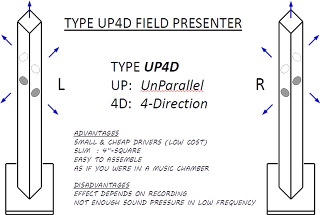I have been studying dynamics of moving masses for multiple-degree of freedom cavity resonator applications. It is interesting, because (I have seen) no study about multiple-degree of freedom model. It is not too much difficult like continuum mechanics. Therefore, I could have developed simulator programs of multiple-degree of freedom models. On the other hand, pipe resonator model is continuum mechanics model, so that it requires another technique to develop simulator models. It is true that just calculating characteristic frequencies of pipe resonator is easy; however, using calculation formulas, we do not know exact behavior of a cavity resonator application. I will not study pipe resonator model for a time being. The reason why I adopted pipe resonator for the field presenter application was not to compensate low frequency response, but to realize slim body. Slim body is advantageous for field presentation, because slim body does not sound field as much as big enclosure b





